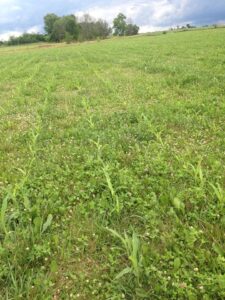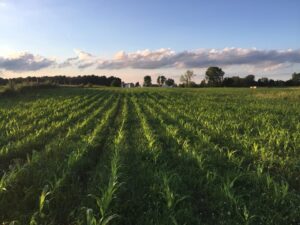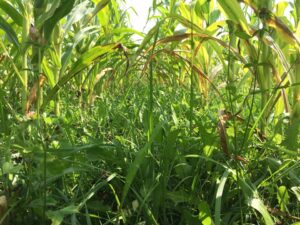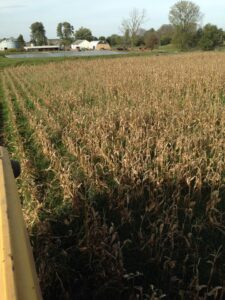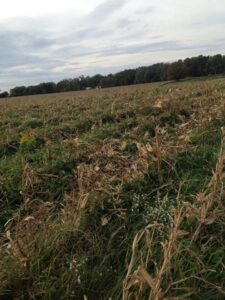Final report for FNC18-1117
Project Information
We are a 3rd generation farm in Howard County, Indiana. On the home 80-acres, the farm has evolved from a diverse livestock and crop farm in the 50's (dairy, beef, sheep, ducks, chickens, wheat, barley, hay, corn, soy, and more) to a confined swine operation that raised corn and soy exclusively by the 90's. Since the hog market crash of 1997, however, we have been slowly returning to a more diverse farm. No-Till was introduced, and practiced almost exclusively for 20 years. Beef cattle began to be rotationally grazed. Chickens and hogs on open pasture were introduced to replenish nitrogen in the pasture lands. And we began to direct-market differentiated meats to consumers.
While cover crops are good, they require an increase in number of times machines must enter the field (an extra planting each fall) and they often require chemical termination in the spring.
Pasture-cropping is a method that leaves the cover crops in place year-round, but intentionally over-grazes to stunt the growth instead of terminating it. On our farm, we have an opportunity to test this method against historic crop performance on a 4 acre field that had been in consistent agronomic use for over 2 decades up until it was devoted to pasture just 5 years ago. Since then, it’s established a dense forage mix of legumes and grasses. But we retain historic yield results for this field to compare.
We will intensely graze this field with a herd of 24 cattle at two intervals, each time forcing them to crop the plants lower to the ground than is desirable for replenishing pasture. First, immediately before planting. Then, again immediately before emergence.
If successful, this method will allow the corn to compete against the stunted forage mix until it canopies. After harvest, it will be immediately productive as forage. Yield loss is expected, but could be offset by other gains.
Previous Research Review
Most significant research has been conducted in the warmer climate of Australia, and with shorter-season grains like wheat. See: https://permaculturenews.org/2012/06/30/pasture-cropping-an-integrated-approach-to-grain-andpasture-production/
Our study will be the first done with the Midwest's staple annual grain product: Corn.
- Discover if intense grazing is a viable method to stunt (in lieu of terminating) pasture before planting and germination.
- Measure the negative effects that the competition creates on grain.
- Determine if the benefits and savings can reasonably offset those yield losses.
Measuring Benefits and Impacts anticipated
Economic Sustainability
Our main goal is to show that a grain operation can reduce their capital outlay (less chemical, fewer times entering the field to plant) and that, while yield may suffer, the economic loss from lower yields is actually offset by real economic value from those savings, plus the added value of forage. To show this, we must determine a market value for the forage tonnage, and measure the effective yield loss incurred to achieve that forage.
Environmental Sustainability
The positive impacts of a perennial crop on land are well established, ranging from soil health and reduced erosion to carbon sequester and drought resistance. This study, if the findings are positive, will make permaculture more viable on many more acres in the Midwest.
Contribution to Sustainable Agriculture
If we find a positive outcome, then we open the possibility for grain and grass-feeding operations to intermix. The forage grown could essentially become a "double crop" opportunity for land owners.
Research
Our project followed our proposed plan very closely. We were able to intensively graze the forage down before planting, continue to graze before emergence, and then watch as the forage and corn competed for nutrients and sunlight. We documented with photography at every step and shared for discussion in our Facebook group, which turned out to be very active. In the end, we harvested and measured yield at the local grain elevator.
To calculate the costs of the project, direct inputs were recorded and easily tabulated. Efforts such as planting, side dressing, and harvesting were all done by us (the farmers) so the costs were not as obvious. For a simple figure, we just used standard custom rates for such services.
The most difficult to calculate was the marketable value of the forage that existed at harvest. We discussed with our collaborators on Facebook and determined that an estimated hay yield and price per bale would be the best. By measuring the average height of the top-growth on the forage, we were able to get an estimated hay yield and current price-per-bale from nearby sellers to assign a market-value to the forage retained.
136.6 dry bushel yield of corn off of 4 acres, measured at the local elevator, averages 34 bpa (bushels per acre).
Forage was estimated 1.75 round bale yield per acre.
The costs saved from not terminating the cover crop and re-seeding were calculated using previous year's costs to terminate and re-drill cover crops.
Educational & Outreach Activities
Participation Summary:
Per our original proposal and plan, the primary outreach medium was a Facebook group where results were constantly posted and real-time feedback solicited. The group is public and can be accessed by any interested parties here: https://www.facebook.com/groups/628823467460604/
The engagement was very encouraging. We began with approximately 25 invited farmers, extension educators, and interested parties to start. Through activity and sharing, however, 64 new people from around the world requested to join the group and follow the progress. Over 50 unsolicited comments, questions, and suggestions came from member engagement as we posted photos regularly to the group.
As we posted the final results, although the results demonstrated that this project was not viable with a corn cash crop, many other suggestions were volunteered and discussed among group participants--ranging from sunflowers to sorghum.
Learning Outcomes
The summary is simple: the value of retained forage, combined with the savings from not terminating and re-drilling cover crop, does not exceed the lost revenue from the corn (even at currently-depressed corn prices).
The details are as follows:
First, the lost revenue was simple. This field had historic yields of 160 bpa (bushels per acre). With the pasture-cropping experiment, it was only 34 bpa. The elevator price on the date of harvest (10/02/2018) was $3.30/bu. That equates to a revenue loss of $415.80 per acre.
The goal of the project was to demonstrate that such a revenue loss might be offset by the cost-savings and value of immediate forage in the fall.
Cost savings include the cost of drilling cover crop and the seed. Based on previous year's costs for this service, that savings totalled $82.58, or just $20.65 per acre. Additionally, the cost to terminate that same cover crop the following spring using recommended application strengths of Roundup and residual burndowns was $22.10 per acre.
The value of the immediate forage was estimated at 1.75 bales per acre, with a market value of $42.50 per bale, or just $74.38 per acre.
The sum of the savings were just $115.13, which does not offset the lost revenue of $415.80.
Project Outcomes
One nearby farmer read about our project on the SARE website and asked to visit and see the project in person. After visiting, we discussed new innovations that could adapt a similar model for future experiments. This farmer, a handy inventor himself, devised plans for a between-the-row mower deck that could be used to continually suppress the forage while the corn canopies. He has plans to put it into testing next season.
One significant factor in our yield loss was NOT the competition for nutrients, although that was what we expected the biggest challenge to be, but instead it was penetration and germination. Land that has been continually grazed for a long period of time has uneven surfaces and uneven compaction, with a difficult-to-penetrate layer of root mass that's far more established than annual cover crops. Weather also did not cooperate, as the ground was very dry by the time the cattle could have stunted the grass. Germination rates were staggeringly low, which led to a difficulty in canopying early, too.
Through an accidental overdose of starter fertilizer on about 50' of the first end-rows, we discovered that the "overdose" was rather effective at giving those rows a jump start at canopy and ultimately a better yield.
Future experiments on this subject will have to explore the question of what to do with the cattle during the 90 days that the corn is growing. Any operation that attempts this model of pasture cropping with more than 10% of their available pasture acreage risks overgrazing their remaining land in order to get a grain crop on the pasture-cropped plot.
